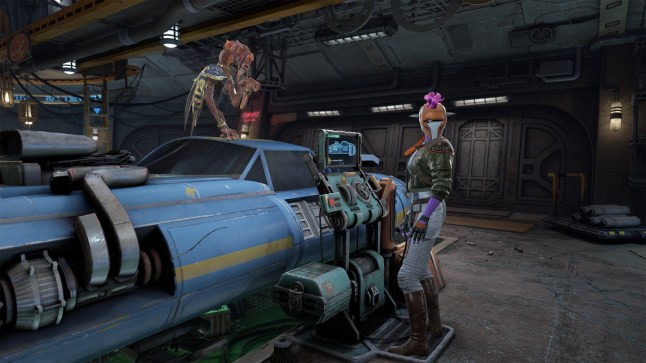
A new Meta Quest VR and AR experience created by special effects masters ILM may be the most immersive Star Wars experience ever, but is it really a game?
Poor old VR. For a medium with so much promise, that’s been knocking around in one form or another since the late 1960s, with occasional massive rounds of investment from multinational corporations, it stubbornly refuses to take off. It will one day, but only when its currently expensive and mildly cumbersome head mounted displays become cheap and easy to put on.
Until then it’s proving to be a protracted chicken and egg situation: there aren’t enough developers making good games for VR, with most waiting until there’s a large enough installed user base, but without enough enticing games few players want to invest in a system. So what you get instead is Meta paying developers to make just about anything for its headsets. Which begs the question: when is a game not a game?
The answer to that is, when it’s a ‘mixed reality playset’. That’s how Star Wars: Beyond Victory bills itself. Presumably the execs at Meta, that greenlit the project, must have loved that, because they’re keener than anyone to push the idea of mixed reality (aka AR or augmented reality) which blends the sights and sounds of your own living room with digital action projected over the top of it.
You can tell how important AR is to Meta by how good the Meta Quest 3, and its more realistically priced sibling the 3S, are at it. Their passthrough cameras, which let you see what’s going on outside the headset, are excellent, providing a responsive and seamless stream of the real world, which can be overlaid with virtual entertainment.
Beyond Victory comes in three parts: the Experience, Arcade mode, and Playset – with the former being easily the most fully formed. It puts you in the shoes of Volo, a plucky but poverty stricken junior pod racer doing his best to compete against better financed teams. It opens with you crashing during a race, one of your pod racer’s engines blowing itself apart for lack of a replacement part you can’t afford.
Soon enough you’re made an offer you can’t refuse by Sebulba, the bad boy of pod racing, whose criminal connections promise to help you become a well-funded champion. It won’t be giving too much away to tell you that things don’t quite go as planned, the story playing out alternately in AR and VR, with the mixed reality sections taking place on a virtual tabletop in front of you.
Expert, exclusive gaming analysis
Sign up to the GameCentral newsletter for a unique take on the week in gaming, alongside the latest reviews and more. Delivered to your inbox every Saturday morning.
The first thing you’ll notice is how solid and beautifully detailed everything looks. You can swing the table around for a closer look, and in many of the scenes you can also zoom in and out using a thumbstick. There are droids, all of which come with familiar sound effects, and plenty of atmospheric Star Wars-infused bric-a-brac to examine.
Because the simulated stuff only takes up a small part of your field of view, it can afford to be unusually high resolution, making everything sharp and detailed, a bit like looking at a perfectly recreated, living diorama. R2 units trundle around, and Volo’s friend and mentor Sornah, an artistically inclined Twi’lek, spends time in her studio that’s located a short distance from the shed that houses your broken down pod racer.
When you go inside any of the buildings the game transitions to VR, giving you a fully immersive experience of being inside them. With more rendering to do, there’s a noticeable drop in resolution in buildings’ interiors, along with a peculiar inverse-TARDIS effect, where structures’ outsides appear considerably larger than their comparatively small internal dimensions.
Despite that disparity, and the blurrier visuals, it’s immediately obvious just how much more intensely the VR sections make you feel as though you’re in the Star Wars universe. Instead of looking down at the action like some sort of well-meaning giant, you’re suddenly part of it. Unfortunately, your interactions with that far more immersive world are uniformly pedestrian.

You’ll be unscrewing panels from your pod racer’s engines, implementing spot welds, and replacing components. It’s busywork, with no particular skill involved, but it does at least make you feel like a mechanic on Tatooine. Conversations with other characters are presented as non-interactive scenes where you typically have a small space to walk around, while passively listening to what other characters have to say.
The script and voice-acting are inoffensive, with slightly cheesy Disney Channel grade performances, its standard issue American accents doing the job just fine, even if no character really stands out. The rest of the Experience is devoted to pod racing, which you undertake in AR, your racer appearing as a tiny craft, maybe 2-3cm in length, speeding across the landscape on the simulated table in front of you.
Because your view’s limited by the size of the table, the draw distance ending at its far edge, you can only see incoming track features when you’re practically on top of them. Races and course designs bear this in mind, but when the meat of a game is racing, and its interface actively gets in the way of that, it’s not just Sebulba’s criminal capers that have gone badly wrong.
There are occasional moments of exquisite chaos when you’re behind in a race, but manage to boost past a couple of rivals before doing a dodge roll just in time to avoid an obstacle or dropped mines, depositing you in the lead while all behind you seems to be exploding. However, not only are those incidents rare, they also feel almost entirely accidental. It’s a sense underlined by the rest of the time where you miss corners, run out of boost, or in one boringly memorable incident, just get stuck underneath a section of track and have to restart the game.
It’s ironic that content like this (you can’t really call Beyond Victory a game), created to show off the mixed reality capabilities of Meta Quest’s hardware, actually goes a long way toward towards undermining the company’s focus on it. AR is a solution desperately in search of a problem. Having the action taking place in front of you, but with your sitting room visible all around it, doesn’t make it better or more interesting, in fact, quite the reverse. When there’s one of the regular switches to VR, your sense of involvement is instantly more compelling.
For all its solidity and charming little details, you can’t help thinking it would have been a lot better and more engaging if it just stuck to VR and stopped reminding you that you’re actually sitting on a sofa pretending to be a pod racer. In the racing, especially, AR adds nothing and instead introduces problems entirely of its own making.
The other two elements of Beyond Victory’s package are Arcade mode, which lets you replay the races from the Experience mode, and Playset, where you can position assets from the game around your room. There are droids, props, and explosions, along with vehicles you can drive around on your floor if you like, but it’s no more than a few minutes’ worth of novelty value.
If this were a freebie, included with advertising for a new Star Wars TV show or Burger King cross promotion, we’d heartily recommend seeing it for yourself. As it is, Star Wars: Beyond Victory wants to charge you £20 for what amounts to around two hours of fairly primitive entertainment, the most substantial parts of which are made actively worse by their presentation in AR. On that basis we’d advise giving this a wide berth, however ardent a Star Wars fan you are.
Star Wars: Beyond Victory review summary
In Short: An extremely insubstantial Star Wars pod racing themed VR and mixed reality experience, that is technically competent but whose greatest value is in demonstrating the limitations of AR as a concept.
Pros: The little dioramas look great and are filled with lovingly replicated Star Wars details, along with warmly familiar sound effects and droids. Pod racing delivers the odd moment of fun.
Cons: VR segments are more immersive but less interactive, while pod racing is hampered by the short draw distance of mixed reality. The John Williams’ theme music is notable by its absence.
Score: 3/10
Formats: Meta Quest 3 (reviewed) and 3S
Price: £19.99
Publisher: Disney Electronic Content
Developer: Industrial Light and Magic
Release Date: 7th October 2025
Age Rating: 7

Email gamecentral@metro.co.uk, leave a comment below, follow us on Twitter.
To submit Inbox letters and Reader’s Features more easily, without the need to send an email, just use our Submit Stuff page here.
For more stories like this, check our Gaming page.




Great insights on the balance between VR and AR in “Star Wars: Beyond Victory.” It’s always interesting to see how different technologies can enhance the gaming experience. Looking forward to more discussions on this topic!
I’m glad you found the insights helpful! The shift towards more immersive VR experiences could really enhance the storytelling aspects, allowing players to feel more connected to the Star Wars universe. It would be fascinating to see how that could change gameplay dynamics!
I appreciate your thoughts! It’s interesting to consider how the balance between VR and AR could impact storytelling in the Star Wars universe. A more immersive VR experience might allow for deeper emotional connections with the characters and settings.
Thank you for your comment! It’s fascinating how the immersion of VR can enhance storytelling in games like this. Focusing more on VR might allow for deeper emotional connections with characters and the storyline.